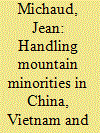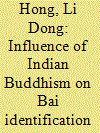| Srl | Item |
| 1 |
ID:
086294


|
|
|
|
|
| Publication |
2009.
|
| Summary/Abstract |
The Chinese in Indonesia suffered considerable discrimination particularly during Suharto's rule (1967-1998). They were considered a foreign threat that needed to be kept under state control. Since the end of Suharto's regime and as a result of liberalisasi, demokratisasi and desentralisasi a revival of Chinese identity has set in, initiating a public discourse on the compatability of Chinese and Indonesian identity. This discourse refers to different categories of identification which are connected with specific conceptualizations concerning the interrelatedness of indigeneity, ethnicity and nationalism in Indonesia and Jakarta in particular.
1This paper is based on the analysis of the relevant literature concerning its theme and of the data gathered during field research in Jakarta between 2000 and 2002 and during shorter stays thereafter. Most responses and statements by informants quoted in this paper have been translated from Indonesian to English. In some cases, conversations and interviews took place in different languages besides Indonesian, namely in English, German and/or Dutch, because informants wanted to practise their foreign language knowledge.
|
|
|
|
|
|
|
|
|
|
|
|
|
|
|
|
| 2 |
ID:
086291


|
|
|
|
|
| Publication |
2009.
|
| Summary/Abstract |
This study considers the official media's portrayal of minority groups in the People's Republic of China. Based on a content analysis of minority-centered articles appearing in the People's Daily newspaper between the years 1950 and 2001, it is found that minorities are most frequently depicted as representatives of primitive cultures. How the government presents this image of primitive minorities, however, has been subject to significant refinement over the years. The government has stepped away from its earlier practice of characterizing 'primitive' minority cultures as pathologies detrimental to the political and economic development of the state in favor of a more recent emphasis on the virtues associated with minority lives. The authors suggest that this transformation in government rhetoric is attributable to changes in both Chinese politics and society.
|
|
|
|
|
|
|
|
|
|
|
|
|
|
|
|
| 3 |
ID:
086290


|
|
|
|
|
| Publication |
2009.
|
| Summary/Abstract |
This paper is an overview of issues pertaining to highland minorities in the three socialist countries sharing portions of the Southeast Asian Massif, namely China, Vietnam and Laos. It presents the historical complexity of highland minority policy in these countries. The paper thus depicts prevalent state strategies that aimed, and largely still aim, to handle highland minorities in the most effective and economical way, to ensure that the nation will progress steadily forward. The six current issues of borders and transnationality, taxonomy, indigenous peoples' status, customary land tenure, tourism and environmental issues are then explored critically.
|
|
|
|
|
|
|
|
|
|
|
|
|
|
|
|
| 4 |
ID:
086289


|
|
|
|
|
| Publication |
2009.
|
| Summary/Abstract |
Exactly when Buddhism spread to the Lake Erhai region continues to be a hotly debated issue among scholars. Upon examining currently available documents and artifacts, however, one starts to see evidence that Indian Buddhism spread to the Lake Erhai region of western Yunnan from the 'Southern Branch of the Silk Road' by about the middle of the seventh century ad.Indian Buddhism has had a profound impact on Bai history and culture, most notably in (1) the spread and assimilation of Acaya Buddhism into Bai culture, and (2) the Bai perception that they are the descendents of King Asoka, India's famous early promoter of Buddhism.
|
|
|
|
|
|
|
|
|
|
|
|
|
|
|
|
| 5 |
ID:
086288


|
|
|
|
|
| Publication |
2009.
|
| Summary/Abstract |
Since the Chinese government began implementing economic reforms in the late 1970s, China has undergone profound economic change and growth. Since then, associated policies have provided many business opportunities in Tibetan areas of China, but Tibetans are poorly equipped to respond to and take advantage of these opportunities. The factors restricting effective market participation are complex and difficult to assess. There are no easy answers. Many political, social, cultural and environmental factors explain the difficulties encountered by Tibetan communities. However, this paper argues that relevant economic development policy is among crucial factors explaining the inability of Tibetans to compete with non-Tibetan migrants.
|
|
|
|
|
|
|
|
|
|
|
|
|
|
|
|